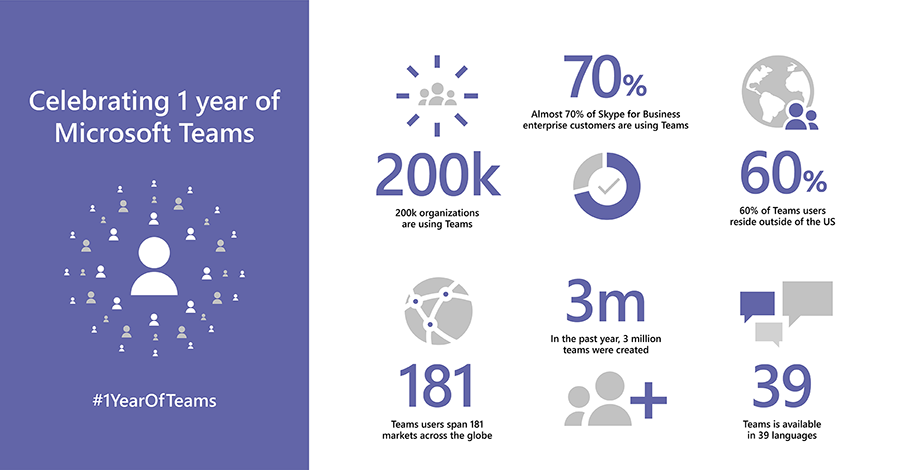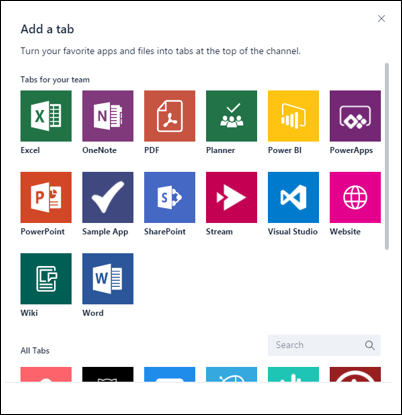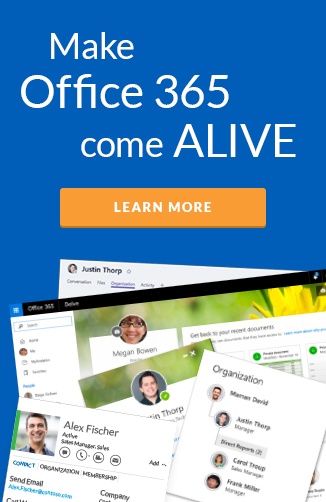Microsoft Teams celebrated it’s one year anniversary on March 12th to a fan fair of 200,000 organizations using it in 181 markets and 39 languages. Three million teams were created in a year! This is an indicator that something is happening and that it’s working.
To mark the 1st birthday of Microsoft Teams we’ve teamed up with the digital experts at Withum to bring you a four-part series and share with you:
- Real-world success stories from Withum customers that are already winning with Microsoft Teams.
- What you need to know and have in place before rolling out
- The hidden gems of Microsoft Teams. Microsoft Teams is feature-rich, we’ll take you through some brand new and lesser known features that can save you time and effort.
In this first part of the series – we talk about how far Microsoft Teams has come and why now is the perfect time to roll it out as part of your digital workplace strategy.

From 0 to 200,000 organizations in 1 year
I believe the core reason for this incredible growth is that organizations that have deployed Office 365 are starting to see past the “we’ve moved our mailboxes to Exchange Online” and looking to “what's next?”.
Creating the “mobile intelligent intranet”, especially if migrating off an existing Intranet, is not an easy task and is an all or nothing move. Sure, you can look to move people off file shares to personal OneDrives, but that also can be a long complex initiative and involves a lot of training and change management. The timeline to move from Skype for Business to Microsoft Teams is also closing in, IT departments are starting to think about this upcoming transition. Microsoft Teams at the beginning of April started to close the gaps on the Skype for Business client too.
Microsoft Teams deployment scenarios can run organization wide or simply be used by individuals or teams to run a remote meeting, or have a discussion via chat, with very little training or guidance.
“Many of our customers understand that this transition will occur in the future, but not many fully understand what they’ll need to do, or what they can do now to ensure that it’s a smooth one.”
Jill Hannemann, Principal for Office 365 and Collaborative Technologies @ Withum

The single pane of glass
Back in January 2017, I made some predictions about the initial preview release of Microsoft Teams. All the feature predictions I made have been shipped, except the higher Tiered compliance for Teams. This is a great sign of the focus and energy in Redmond to get this right. The recent Enterprise Connect 2018 conference had a variety of feature announcements in the keynote we will see in coming months. These primarily revolved around the voice and video calling capabilities.
I believe that with SharePoint focusing its lens (on mobile and intelligent intranets and being the content service for other apps), that Microsoft Teams will become the primary used Office 365 service in organizations other than Outlook. The main reason for this is because Microsoft Teams is not only the messaging, voice and video capabilities, but also the single pane of glass through to SharePoint, OneDrive, Planner, OneNote, Power BI, PowerApps and more through Tabs, bots and connectors. All of which is wrapped around the managed security membership of an Office 365 group.
“A challenge that many have seen with Office 365 is having all the disparate workloads that perform similar functions. Many users are looking for that integration, and Teams provides that ‘single pane of glass’ or the workspace where you don’t have to think about what application you’re working in or need to reference.” Jill Hannemann
Many will compare Microsoft Teams to Slack as an alternative here. Even Slack felt threatened on the preview announcement getting a full page ad in the New York Times. On the surface they are similar products, but it becomes very clear that Slack is far behind in the feature set to Microsoft Teams. This is due to the way that it has embraced its sister services in Office 365 and its long-term play in voice and video with Unified Communication Services/Lync/Skype for Business.

Quick win success
Microsoft Teams has a quick win feel to it, where it can organically grow for a new project initiative, or a new way for a team to work more effectively together.
We’ve had a great response from the 5 tips to improve your usage of Microsoft Teams I wrote back in July 2017 too. Organizations using Microsoft Teams have signed up to our free Hyperfish Lite service, that reaches out to users to ensure they have a photo in their profile to make the user experience that much better in Microsoft Teams.
In the next two parts of this series, Withum will be imparting their expert advice on:
- How to set your organization up to succeed with Microsoft Teams (Read Part 2 now), and
- The real results their customers are achieving through Teams
“In our history, we’ve launched or migrated over 400 instances of SharePoint starting with WSS and today more frequently with Office 365/SharePoint Online. What we see is simple, the basic needs for collaboration have not changed, but the technology has gotten better. Where groups of people used to have to request a Team Site in SharePoint, now they only need to request a new Microsoft Team or perhaps create a new channel in an existing team. Getting started is more so a challenge with change management, than technology. What I mean by this, is setting governance parameters around the usage of Teams and providing clear messaging to users.” Jill Hannemann.
We hope you tag along for the ride!

Already have a Microsoft Teams success story?
Feel free to share in the comments of the posts.
